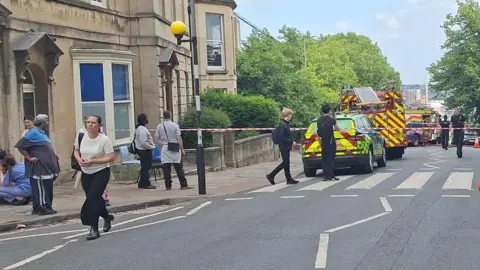LIVE: UN urges Israel to allow medical evacuation from Gaza amid ceasefire | Gaza News
World Health Organization says 41 critical patients evacuated yesterday as Rafah border remains shut, despite ceasefire.
Published On 23 Oct 2025
World Health Organization says 41 critical patients evacuated yesterday as Rafah border remains shut, despite ceasefire.
Published On 23 Oct 202523 Oct 2025
Share
“She went into labour and gave birth on the side of the road while trying to find help.”
UNICEF spokesperson Tess Ingram explains the desperate conditions families find themselves in while being forcibly displaced from Gaza City by Israeli evacuation orders.
Published On 15 Sep 202515 Sep 2025
Share
A Palestinian mother filmed the panic and confusion, screaming for her son after she said an Israeli strike targeted their neighbour’s home as they were preparing to evacuate. Palestinians in Gaza City say Israel often gives only 15–30 minutes’ warning before striking buildings.
Published On 12 Sep 202512 Sep 2025
Share
Published On 11 Sep 202511 Sep 2025
Share
Roughly 200,000 Palestinians have fled besieged Gaza City in recent weeks, according to Israeli military estimates reported by Israeli media, with tens of thousands departing in recent days as military operations intensify.
Amnesty International and other human rights organisations have denounced Israel’s escalating offensive in northern Gaza, warning of “catastrophic and irreversible consequences” for Palestinian civilians.
Israel has issued renewed forced evacuation directives for approximately one million people to evacuate Gaza City, where it has stepped up bombardment of high-rise buildings while preparing for the next phase of military action in what it claims is Hamas’s final stronghold. On Wednesday, the Israeli military announced imminent increases in targeted strikes near Gaza City.
Palestinians are being forced to move southward, where hundreds of thousands already endure overcrowded tent settlements that Israel periodically strikes.
Many residents decline to leave, citing exhaustion and a lack of resources.
“There is no safe zone in the Gaza Strip,” said Fawzi Muftah, as people travelled with vehicles loaded with possessions. “Danger is everywhere.”
Amal Sobh, displaced with 30 family members, including 13 orphans, recounted being stranded after their vehicle broke down without fuel.
“We do not have good blankets or good bedding, and winter is coming. What do we do for our children? We do not even have a proper tent to shelter us,” said Sobh, whose husband was arrested during the conflict.
According to the Gaza Health Ministry, 126 Palestinians, including 26 children, have died from malnutrition-related conditions since famine was declared in Gaza City on August 22. Throughout the war, 404 people, including 141 children, have perished from malnutrition.
Israel’s war on Gaza has killed at least 64,656 people and wounded 163,503 since October 2023, with tens of thousands more believed to be trapped beneath rubble.
Published On 6 Sep 20256 Sep 2025
The Israeli army has bombed another high-rise in Gaza City after telling Palestinian residents to evacuate or face being killed amid its ongoing siege and imposed mass starvation in the enclave.
The Israeli military designated more high-rise towers as targets in a map released on Saturday. Shortly after releasing the map, it bombed the 15-storey Soussi Tower, which is located opposite a building belonging to the United Nations agency for Palestinian refugees (UNRWA) in the Tal al-Hawa neighbourhood.
list of 3 itemsend of list
“These attacks are causing panic amongst the people, especially considering the time they are given to evacuate. Half an hour or an hour is not enough time for people to escape from these buildings,” Al Jazeera’s Hani Mahmoud said, reporting from Gaza City.
The Israeli military said in a statement, without offering evidence, that the buildings struck were used by Hamas to gather intelligence to monitor the locations of the Israeli army. It also said armed Palestinian groups planted “numerous explosive devices” and dug a tunnel in the area.
Gaza’s Government Media Office rejected the claims and called them “part of a systematic policy of deception used by the occupation to justify the targeting of civilians and infrastructure” and forcibly displace Palestinians from their homes. It said 90 percent of Gaza’s infrastructure has been destroyed by Israel.
The targeted buildings were near the 12-storey Mushtaha Tower, which on Friday was similarly bombed and razed to the ground, as Israel moves to seize Gaza City despite international criticism.
At least 68 Palestinians were killed and 362 wounded across the Gaza Strip by the Israeli military over the past day, the enclave’s Ministry of Health said on Saturday afternoon.
The toll includes 23 aid seekers killed and 143 wounded by Israeli forces. At least six more Palestinians also died of Israeli-induced starvation, bringing the total number of starvation deaths during nearly two years of war to 382, including 135 children.
At least 64,368 Palestinians have been killed and 162,367 wounded by Israel since the start of the war in the aftermath of the Hamas-led attacks on southern Israel on October 7, 2023.
Sources at Nasser Hospital, located in southern Gaza’s Khan Younis, told Al Jazeera that at least two Palestinians were killed and many wounded in an Israeli air strike on a tent housing displaced people in the al-Mawasi area.
While this area was designated as a “humanitarian” or “safe” zone by the Israeli army early in the war, it has been repeatedly bombed, leading to the deaths of hundreds of displaced civilians.
Hours before the latest bombings, the Israeli army had announced the establishment of another similar zone in al-Mawasi, which runs along Gaza’s Mediterranean coast. It claimed the area will have infrastructure such as field hospitals, water lines, desalination facilities and food supplies.
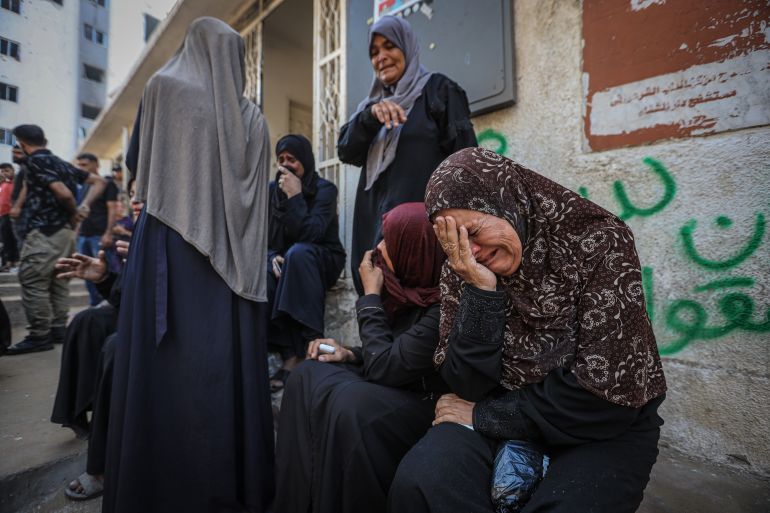
Reporting from central Gaza’s Deir el-Balah, Al Jazeera’s Hind Khoudary said Palestinians do not trust the so-called humanitarian area as tents in similar zones have been attacked by Israel many times before and nowhere is safe.
But people in Gaza City have few options: If they stay, they risk being killed, and if they leave, they face dangers on the road and may have to spend considerable money to move their belongings south.
Those who have returned to their homes in Gaza City’s Zeitoun neighbourhood, where Israeli forces withdrew recently after weeks of ground assaults, have found everything they owned destroyed.
“What we have built in 50 years was flattened in five days,” resident Aqeel Kishko told Al Jazeera. “Nothing remains standing – buildings, roads and infrastructure. We are walking not only on ruins but also on dead bodies of our loved ones.”
Nohaa Tafish said it would be impossible for Gaza’s largest urban centre to be revived.
“What would people return to? There is nothing to return to,” she said.
Ahmed Rihem also had his home in Gaza City reduced to rubble. “It is as if the entire Zeitoun neighbourhood was hit with a nuclear bomb,” he said.
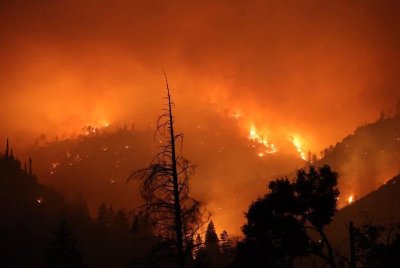
As of Saturday evening, nearly 200 people were under evacuation orders due to the Pickett Fire in Napa County. Photo courtesy of the Cal Fire Sonoma-Lake-Napa Unit
Aug. 24 (UPI) — A wildfire in Northern California has grown to nearly 7,000 acres, prompting evacuations in Napa County, forestry officials announced Sunday.
The Pickett Fire, which was sparked Thursday in Calistoga, was 6,803 acres as of midday Sunday with 11% containment, according to a status report from the California Department of Forestry and Fire Protection. Twenty-four hours earlier, the blaze was about 4,700 acres with 7% containment.
Cal Fire said much of the new growth occurred near the eastern edge of the wildfire. There’s been no confirmed damage to any structures.
Officials ordered evacuations for areas near Calistoga, west of Pope Valley Road. Evacuation warnings were also issued for threats to life and/or property.
The Bay Area Air Quality Management District also issued an air quality advisory in Napa, Solano and Sonoma Counties due to smoke from the Pickett Fire. The advisory was in place through Monday. The smoke could be dangerous to older adults, children and pregnant people, as well as those with heart problems.
The US State Department has stopped all visitor visas for Palestinians arriving for urgent medical treatment from Gaza while it ‘reviews’ how approvals are handled. Aid groups have slammed the decision saying it blocks critically ill children from receiving life-saving treatment in the US.
Published On 17 Aug 202517 Aug 2025

Hundreds of firefighters were battling a massive wildfire from the ground and the air on the Greek island of Crete. Photo by Nikos Chalkiadakis/EPA
July 3 (UPI) — As many as 1,500 people were evacuated from areas of the Greek island of Crete as wildfires burned out of control, fanned by gale-force winds, authorities said.
The fire, centered in the far southeast of the island, broke out in a forested area Wednesday, rapidly spreading toward the town of Ierapetra, forcing authorities to order residents and tourists in five surrounding settlements to move.
Some people whose escape routes were cut off by the fire had to be rescued from beaches by boat. At least four elderly people were hospitalized with respiratory problems due to smoke inhalation.
Displaced people were provided with makeshift accommodation in Ierapetra in an indoor sports center or hotel rooms, where available.
More than 150 firefighters, 38 fire trucks and four helicopters dropping water were deployed with two specialist forest-firefighting units from the Greek mainland en route to the scene to provide back-up.
That number rose to more than 230 on Thursday, but firefighters, facing a wall of flames almost four miles across with visibility down to zero, were forced into a tactical retreat for safety reasons and to focus on firebreaks to protect settlements being threatened by the fire.
Homes and rental properties in the beachfront village of Agia Fotia, 8 miles east of Ierapetra, have been destroyed and the settlement and surrounding area were without power.
The fire service, which has been issuing alerts and evacuation instructions via mobile phone messaging, warned in its daily update that the risk of wildfires remained high across Crete and parts of southern Greece.
The emergency on Crete came after authorities in Turkey’s nearby Izmur region evacuated 50,000 people in the face of wildfires in recent days.
Scientists have designated the Mediterranean, including much of Greece, a “wildfire hotspot” as blazes become ever more frequent and destructive during hot, parched summers. Governments of the affected countries say the climate crisis is the cause.
All of Europe is currently sweltering in a deadly heatwave with temperatures topping out at 46 degrees Celsius in southern Spain and 40 degrees Celsius in Paris, although temperatures in the eastern Mediterranean held closer to normal in the high 20s to low 30s degrees Celsius.
Spain, Italy and France recorded at least eight deaths connected to the extreme heat.
The blaze comes as southern Europe contends with an acute summer heatwave which has killed people in several countries.
A wildfire on the Greek island of Crete has led to the evacuation of more than 1,500 people, local media outlets have reported, as an early summer heatwave continues to grip southern Europe.
At least 230 firefighters, some dispatched from Athens, were attempting on Thursday to contain the blaze, which broke out on Wednesday evening near Ierapetra, a town on the island’s southeastern coast.
Elsewhere, a wildfire killed at least two people in the northeast Spanish region of Catalonia, and heat-related deaths have also been recorded in France and Italy this week.
Spread by gale-force winds, the blaze on Crete reached houses and hotels, according to local authorities, who said dozens of residents and tourists had been evacuated to an indoor stadium in Ierapetra.
“Three settlements were evacuated and more than 1,000 left their homes. Some were taken to health centres with respiratory problems,” George Tsapakos, Crete’s deputy civil protection governor, told public broadcaster ERT.
Meanwhile, Vice-Prefect Yannis Androulakis confirmed that the blaze, which currently has “three active fronts”, had spread quickly because of strong winds.
“There are still a number of different fronts. The fire is burning scrubland and crops,” he said. “The winds are very strong – up to nine on the Beaufort scale.”
In an interview with the TV channel Mega, Androulakis added that water bomber planes were unable to reach the affected areas overnight.

Drones and 10 helicopters were also being used to fight the fire, according to a spokesperson for the Greek fire service.
In its daily bulletin on Thursday, the fire service warned that the risk of wildfires in Crete and southern Greece remained very high.
Last year, Greece experienced its warmest summer ever, with 45,000 hectares (111,200 acres) torched by wildfires, according to WWF Greece and the Athens National Observatory.
Even more land was damaged in 2023, when almost 175,000 hectares (432,400 acres) were affected by wildfires as temperatures hit 46 degrees Celsius (115 degrees Fahrenheit).
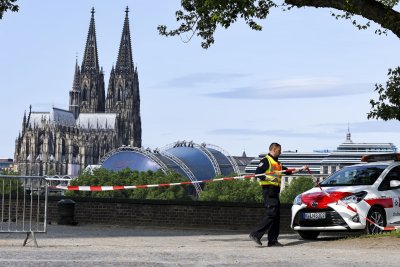
A Cologne public order officer cordons off access to the Rhine River promenade on Wednesday after three unexploded bombs from the Second World War were found at the Deutzer Werft, forcing a large area of the center of the city to be evacuated. Photo by Christopher Neundorf/EPA-EFE
June 4 (UPI) — More than 20,000 people in Germany were evacuated as authorities worked Wednesday to defuse three huge unexploded bombs from World War II at a construction site in the center of the city.
A major incident was declared due to the danger from the bombs — two 2,200 lb devices and one of 1,100 lbs — with police making checks door-to-door in the Old Town and Deutz areas of Cologne after 20,500 people were ordered to leave and businesses, tourist attractions and stations were shuttered, the city said in a news release.
The 1,100-yard-wide exclusion zone covers the city’s UNESCO-listed 13th-century cathedral, 58 hotels, parts of the subway system, at least nine schools, day care centers, two retirement homes, a hospital, as well as city hall and many other sites.
“The evacuation is the largest measure since the end of the Second World War. Everyone involved hopes that the defusing can be completed in the course of Wednesday,” city authorities said.
“This is only possible if all those affected leave their homes or workplaces early and stay outside the evacuation area from the outset on that day. We ask you to be cooperative and follow our instructions so that the evacuation and defusing can proceed quickly and without danger.”
Officials told Sky News the measures could remain in force for some time if the effort to defuse the devices was unsuccessful and it became necessary to detonate them, as that would require a major operation to contain the blast.
All three bombs are American-made, but likely dropped by the Royal Air Force, which dropped around 1.5 million bombs in raids on Cologne between 1940 and 1945, some of them with as many as 1,000 aircraft, launched from bases in eastern England.
However, as many as 300,000 of the bombs did not explode, according to experts, causing frequent scares when they turn up during construction projects or in dredging of the River Rhine, which runs through the heart of the city.
Last year alone, more than 30 were discovered, forcing 17 evacuations affecting 36,000 people. The bombs were among around 2,000 that are found across Germany each year, according to the Smithsonian Magazine.
In 2021, four people were injured in Munich when a World War II bomb exploded during construction work near the main train station and more than 65,000 people were evacuated in Frankfurt in 2017 after a “Blockbuster” 1.4-ton British bomb was found near Goethe University. That device was safely defused.
German bombs are frequently discovered in Britain, which was heavily bombed by the Luftwaffe between 1940 and 1941 and in 1944, most recently last year when 10,000 people were evacuated after a large bomb was found in the yard of a suburban property in Plymouth.
Naval and army bomb disposal officers extracted the device and took it out to sea, where it was detonated.
BBC News, Bristol
Pregnant women have been evacuated from a maternity hospital after a large fire broke out.
Black smoke was seen over St Michael’s Hospital on Southwell Street, in Bristol shortly before 16:30 BST. Firefighters from Avon and Fire and Rescue Service are attending and say the fire has now been extinguished.
Pregnant women and babies were moved outside of the building, supported by midwives who brought out milk and fruit.
Jess Hutchinson, 22, whose waters have broken, said it was “scary” hearing the fire break out on the roof – where a number of solar panels have been destroyed by the flames.
The public has been asked to avoid the area where possible.


Matthew Burden, from Weston-super-Mare, was inside the maternity unit with his wife when the fire broke out.
He said she was in labour with their third baby and he was “really eager to get back” to her.
“I went out to get some food, came back and obviously the alarm went off,” he said.
“They said all partners had to leave. Everyone was going down the fire exit quite fast.
“When we came out I saw black smoke, all up in flames.”
He said he has spoken to his partner on the phone and said she is safe inside.
Some of the women have been taken to the Bristol University Life Sciences building.

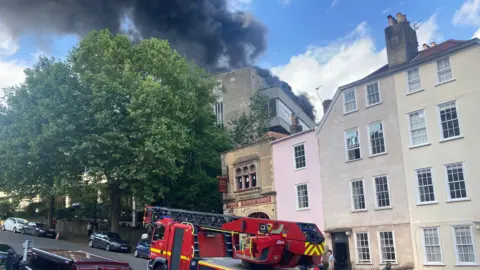
A spokesperson for the fire service said: “We can confirm that the fire has safely been extinguished.
“The cause of the fire will be investigated.”
Avon and Somerset Police said it was supporting the fire service at the scene.
In a statement on X, the force said: “St Michael’s Hill is closed to vehicles and pedestrians and people are urged to avoid the area if at all possible.”
A spokesperson for University Hospitals Bristol and Weston NHS Foundation Trust, which runs the hospital, said the trust is responding to “an incident” and will “provide a further update shortly”.

